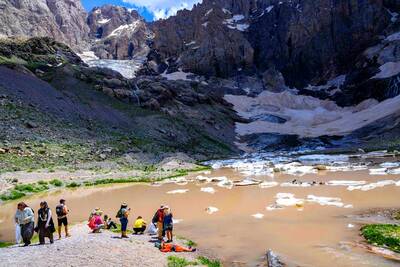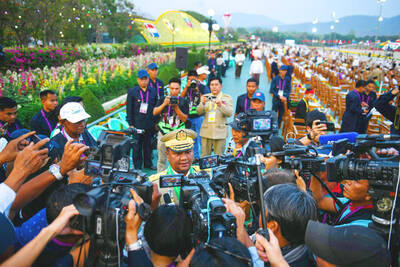A series of militant bomb attacks in Pakistan aims to undermine the country’s resolve to fight the Taliban but is likely only to strengthen determination to defeat the militants, analysts say.
Pakistan has undertaken its most concerted effort to roll back an expanding Taliban insurgency that has raised fears for the important US ally’s stability, and for the safety of its nuclear weapons.
The army late last month went into action against Taliban who had seized a district only 100km from the capital after the US criticized a peace pact as tantamount to abdicating to the militants.
This month, the military launched a full-scale offensive to root out the Taliban from their stronghold in nearby Swat.
But the militants have responded with eight bomb attacks in towns and cities since late last month, three on Thursday in the northwest, a day after 24 people were killed in a suicide gun and bomb attack in the eastern city of Lahore.
The militants are trying to undermine the state’s determination to fight them, and the broad public support the army’s campaign enjoys, analysts told reporters yesterday.
“This is exactly what the militants are trying to do because they have done it successfully in the past. But things have changed substantially,” security analyst Ikram Sehgal said.
“I don’t think it will undermine the resolve of either the public or the government. They realize that this sort of thing will only escalate if they vacillate any further,” he said.
Pakistan signed up to the US-led campaign against Islamist militancy after the Sept. 11, 2001, attacks in the US but at best ambivalently.
Pakistan had used Islamist fighters to oppose Soviet occupiers in Afghanistan in the 1980s and later backed the Afghan Taliban. Militants were also used to oppose India in the disputed Kashmir region. Pursuit of strategic interests apparently at odds with US aims and mixed messages from the state and media brought muddle.
But not anymore.
The Taliban overplayed their hand when, under cover of a controversial peace pact, they denounced the Constitution and pushed out of the former tourist valley of Swat toward the capital.
“The Taliban attempt to make their presence felt in an area that a large number of Pakistanis are familiar with, and the way they went about it, the brutality, exposed them and changed opinion,” Samina Ahmed of the International Crisis Group think-tank said.
“They are no longer considered alienated, disaffected Pakistanis who need to be brought into the fold. They’re looked upon much more as criminals who should be brought to justice,” she said.
The violence the militants have unleashed demonstrated the extent of the threat they posed and is steeling opposition, Ahmed said.
The state now has to show it can finish the offensive in Swat quickly.
“Their main aim is to weaken public opinion, especially in Punjab,” said retired Brigadier Asad Munir, a former intelligence agency officer, referring to Pakistan’s most prosperous and politically important province, of which Lahore is the capital.
“You won’t see this now, but if the operation is prolonged then things will start changing. They have got to do it in a week or 10 days,” he said of the Swat operation.
Wavering at this stage would dash the hopes of the public and be disastrous, he said.
“If they stop the operation now then prepare yourself for a Taliban state,” he said.

In the sweltering streets of Jakarta, buskers carry towering, hollow puppets and pass around a bucket for donations. Now, they fear becoming outlaws. City authorities said they would crack down on use of the sacred ondel-ondel puppets, which can stand as tall as a truck, and they are drafting legislation to remove what they view as a street nuisance. Performances featuring the puppets — originally used by Jakarta’s Betawi people to ward off evil spirits — would be allowed only at set events. The ban could leave many ondel-ondel buskers in Jakarta jobless. “I am confused and anxious. I fear getting raided or even

Kemal Ozdemir looked up at the bare peaks of Mount Cilo in Turkey’s Kurdish majority southeast. “There were glaciers 10 years ago,” he recalled under a cloudless sky. A mountain guide for 15 years, Ozdemir then turned toward the torrent carrying dozens of blocks of ice below a slope covered with grass and rocks — a sign of glacier loss being exacerbated by global warming. “You can see that there are quite a few pieces of glacier in the water right now ... the reason why the waterfalls flow lushly actually shows us how fast the ice is melting,” he said.

RISING RACISM: A Japanese group called on China to assure safety in the country, while the Chinese embassy in Tokyo urged action against a ‘surge in xenophobia’ A Japanese woman living in China was attacked and injured by a man in a subway station in Suzhou, China, Japanese media said, hours after two Chinese men were seriously injured in violence in Tokyo. The attacks on Thursday raised concern about xenophobic sentiment in China and Japan that have been blamed for assaults in both countries. It was the third attack involving Japanese living in China since last year. In the two previous cases in China, Chinese authorities have insisted they were isolated incidents. Japanese broadcaster NHK did not identify the woman injured in Suzhou by name, but, citing the Japanese

RESTRUCTURE: Myanmar’s military has ended emergency rule and announced plans for elections in December, but critics said the move aims to entrench junta control Myanmar’s military government announced on Thursday that it was ending the state of emergency declared after it seized power in 2021 and would restructure administrative bodies to prepare for the new election at the end of the year. However, the polls planned for an unspecified date in December face serious obstacles, including a civil war raging over most of the country and pledges by opponents of the military rule to derail the election because they believe it can be neither free nor fair. Under the restructuring, Myanmar’s junta chief Min Aung Hlaing is giving up two posts, but would stay at the